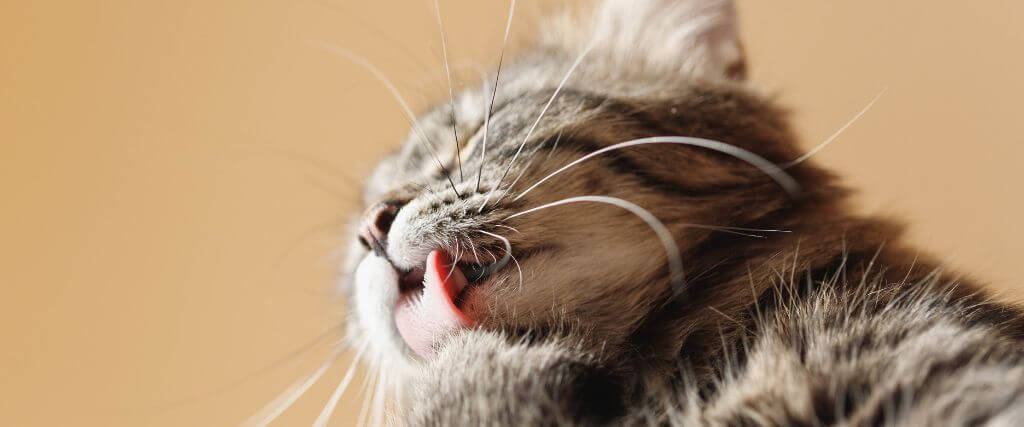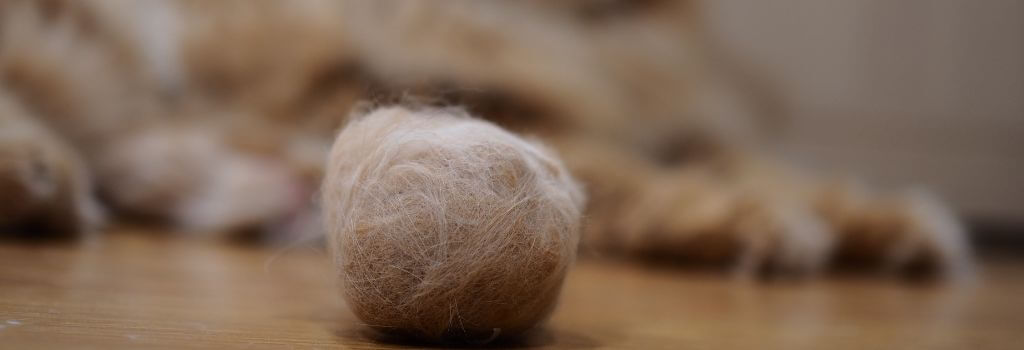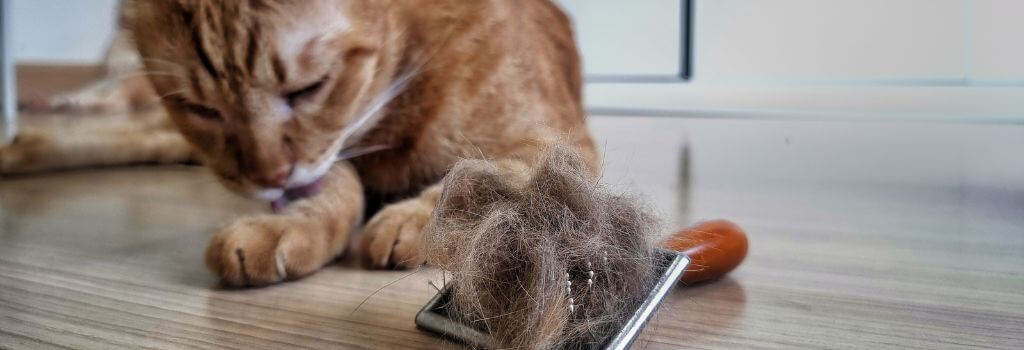
Based on an article that first appeared at
Catawba Heights Animal Hospital
Ah, the joys of cat ownership: the purring, the playful attacks on your toes, and, of course, the occasional surprise hairball on your carpet. If you’ve ever been serenaded by the unmistakable sound of your cat hacking up a hairball, you’re not alone. While often considered a normal part of cat ownership, hairballs hold a fascinating blend of biology, grooming habits, and health implications that warrant a closer look.
As a veterinarian, I know that hairballs are one of the most common issues for cat pet parents. So let’s take some time to understand hairballs! From their formation to their hopeful expulsion. We’ll cover everything cat owners need to know. Get ready to discover the surprising world of hairballs, and when it’s time to transition from a mild eye-roll to genuine concern.
What Exactly Are Hairballs?
If you want to impress a friend, here is a fun fact: hairballs actually have a scientific name that matches their appearance– trichobezoars. That’s a mouthful, and no matter what you call them, they are exactly what they sound like, wads of hair that didn’t make the journey all the way through your cat’s digestive system. They usually resemble small, elongated tubes of compressed fur – less like a ball and more like a fuzzy, wet caterpillar.
If you have a feline friend, you know firsthand that cats are meticulous groomers, spending a significant portion of their day primping and preening. While their tongues are excellent at catching loose fur, this also means they swallow a lot of it. Most of this fur passes through their system without a hitch, but sometimes, it decides to stick around in the stomach, eventually being returned to you, the lucky owner, as a hairball.
They don’t always make it back up for the owner, and this is a bigger problem than having to scrub the carpet. If hairballs don’t pass through the digestive tract or get regurgitated, they can lead to potential blockages, which is a serious health concern for cats.

Managing Hairballs
The Role of Diet in Managing Hairballs
Diet can play a big role in hairball management. For cats, a well-balanced diet isn’t just about nutrition; it’s about promoting the natural passage of ingested fur through their digestive systems.
Cat food formulas designed specifically for hairball control include a blend of dietary fibers. These fibers serve a dual purpose: they help to bind the hair ingested during grooming and promote its smooth transit through the digestive tract. Some specialized hairball control foods are formulated to improve coat health and decrease shedding, too!
By increasing the movement of hair through the stomach and intestines, these diets reduce the likelihood of hair accumulating into a ball and causing discomfort or, worse, blockages. While diet alone might not eliminate hairballs entirely, it can significantly reduce their frequency and severity, contributing to a happier, healthier life for your cat.
And don’t forget about staying well-hydrated. Moisture-rich diets, such as those that include wet food, can assist in preventing hairballs. The additional water content in wet food helps to keep the digestive system lubricated, which is important for the movement of hair through the gastrointestinal tract.
For cats that frequently struggle with hairballs, your veterinarian may recommend a multifaceted approach to management above and beyond a specilized hariball formula diet and increase water intake.
Other suggestions that your veterinarian may give:
- Regular Grooming: Brushing your cat regularly, especially if they have long fur, can significantly reduce the amount of hair they swallow during self-grooming. Over 65% of long-haired cat breeds are likely to experience hairballs more frequently than their short-haired counterparts. However, regardless of fur length, around 35% of all cats will present with hairball issues at some point in their lives, making it a concern among cat owners worldwide.
- Hairball Remedies: These are gel or paste supplements that act as lubricants to help hairballs pass more easily through the digestive system.
- Fiber Supplements: In some cases, a veterinarian might suggest adding a bit of pumpkin or a commercial fiber supplement to your cat’s diet to aid in digestion and hairball passage.
- Regular Veterinary Check-ups: Regular exams can help monitor your cat’s health and adjust treatments as needed.
- Investigation of Underlying Issues: If hairballs are frequent and severe, your veterinarian might look into underlying skin issues or digestive problems that could be exacerbating the problem.
- Probiotics: Sometimes, vets may recommend probiotics to help maintain a healthy balance of bacteria in the gut, which can aid digestion and potentially reduce hairball formation.

When to Shift from Annoyance to Concern
While hairballs are a common feline occurrence, they shouldn’t be a frequent feature of your cat’s life. Excessive hairballs or difficulty expelling them can be signs of underlying issues such as digestive problems, excessive grooming due to stress or skin issues, or even dietary concerns. If your cat is coughing up hairballs more than once a month, struggling to expel them, or showing signs of distress, it’s time to consult your veterinarian.
When hair accumulates in the stomach or intestines without being expelled, it can form a dense, compact mass, making it difficult for food to pass through. This can lead to a gastrointestinal obstruction, a condition that requires immediate veterinary attention.
- Symptoms of a Blockage: Signs that a hairball has caused a blockage include persistent vomiting (especially without producing a hairball), lethargy, lack of appetite, constipation, or diarrhea. The cat may also show signs of abdominal pain and discomfort.
- Treatment: If a blockage is suspected, your veterinarian will likely use imaging tools such as X-rays or ultrasound to confirm the presence of an obstruction. Treatment typically involves surgical removal of the hairball. This is a more serious procedure than the preventive measures for typical hairballs, emphasizing the importance of managing and minimizing hairball formation through diet, grooming, and veterinary care.
Hairball Harmony
Hairballs can be an ordinary part of cat ownership, but they shouldn’t be overlooked. They are a small price to pay for the joy our whiskered companions bring into our lives! Remember, if hairballs become a frequent or distressing problem for your cat, your veterinarian is just a phone call away.
Work with your veterinarian for tailored advice and solutions to support your feline friend and keep them comfortable and hairball-free. After all, we’re here to help you navigate the furrier aspects of pet care, ensuring you and your feline friend enjoy many happy, hairball-minimized years together!
If you have questions and you’d like to reach out to us, you can call us directly at (706) 801-1008, or you can email us at appt@hillhighanimal.com. Don’t forget to follow us on social media Facebook, Instagram.
